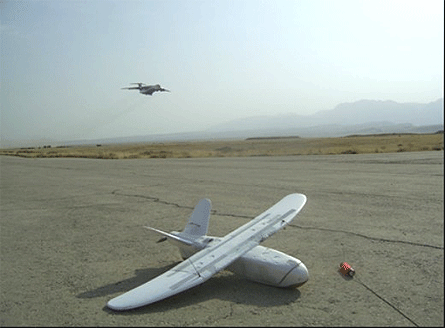The British Army is to field the Lockheed Martin Desert Hawk III UAV in Iraq from next month as part of a transition to the more advanced variant from existing Desert Hawk 1+ aircraft.
The service has also confirmed that it experienced a near-miss incident involving a Desert Hawk and one of its Boeing CH-47 helicopters on 9 November last year.
The near miss occurred in the Sangan valley region of Afghanistan during a fire fight with Taliban forces according to Maj Paul Tombleson, second in command of 32 Regiment Royal Artillery, which operates all British Army UAV systems.
Speaking at the Bristol International UAV conference 16 April, he said both aircraft were operating at low altitude with the helicopter pilot failing to follow instructions on how to transit a designated Desert Hawk operations box. The UAV was able to video the helicopter at close range. Neither aircraft was damaged in the incident.
“The Desert Hawk was exactly where it was supposed to be…The Desert Hawk was tasked to the north-east corner of a 10km [5.4nm] restricted operating zone and parked up there while the Chinook was tasked into a helicopter landing site. He was told to approach from the west. He didn’t, he approached from the east and bloody near flew into the Desert Hawk.”
The closing speeds of the two air vehicles would have meant that the 3kg (7lb) all-up weight of the Desert Hawk would have been the equivalent of a 225kg weight hitting the helicopter windscreen, Tombleson said. “The lesson was learned; those tapes were played to the aircrew.”
The British Army has now converted three 32 Regiment Royal Artillery UAV batteries, formerly operating the BAE Systems Phoenix, over to Desert Hawk, Tombleson said.

Army Desert Hawk's are being progressively upgraded to Desert Hawk III configuration
“We have got one battery in America at the moment we are converting to Desert Hawk III before coming to Iraq next month.
“We have done two complete operational deployments in Afghanistan - that is 18 and 42 battery. 57 battery’s deployment is ongoing; they actually assumed responsibility last night.
“We have supported 16 Brigade, 3 Commando Brigade, we are starting to support 12 Mechanised Brigade; we will be supporting 1 Mechanised Brigade in Iraq by about the middle of June with a new air vehicle capability.”
12 Mechanised Brigade took over the UK’s operations in Afghanistan on 12 April. 1 Mechanised Brigade is to deploy to Iraq next month.
More than 1,400 operational Desert Hawk flights have been carried out since the system entered UK service last year, Tombleson said, meaning “the lessons that we have picked up have a degree of pedigree behind them”.
He told the conference that Desert Hawk is reiterating the need for full integration of intelligence, surveillance, targeting and reconnaissance (ISTAR) assets within the land component. This is particularly critical for co-ordination of operations over extended periods of time and geography, as well as for providing the basis for joint operations with other operational components.
There is however, a balance to be struck between intelligence gathering and other UAV roles in the ISTAR planning process. “There is a tension between intelligence gathering, and this is particularly an issue for the ISTAR stuff because a lot of the focus is on intelligence gathering, and as soon as they put their emphasis in that area you see a reduction in the effort in terms of the here-and-now effort on surveillance and target acquisition and to a slightly lesser extent reconnaissance. That can only be overcome through education.”
The army has begun using Mission Technologies Buster mini-UAVs acquired under the former Joint UAV Experimentation Programme as Desert Hawk surrogates to support brigade-level familiarisation training in the UK ahead of operational deployments to help overcome the planning issue.
Desert Hawk is also making clear to the army that “there is no-size-fits-all UAV. There are a lot of mini UAVs, there are a lot of tactical UAVs in the fleet of operational UAVs and anybody who tries to sell you one as the be-all and end-all, big panacea – buy this and you don’t need anything else – is wrong.”
Source: FlightGlobal.com























